Themed collection Dalton Transactions Inorganic Symposia

Evaluating the component contribution to nonlinear optical performances using stable [Ni4O4] cuboidal clusters as models
Cuboidal [Ni4O4]-based clusters are systematically studied with the purpose of evaluating the component contribution to the overall nonlinear optical performances.
![Graphical abstract: Evaluating the component contribution to nonlinear optical performances using stable [Ni4O4] cuboidal clusters as models](/en/Image/Get?imageInfo.ImageType=GA&imageInfo.ImageIdentifier.ManuscriptID=C8DT02080A&imageInfo.ImageIdentifier.Year=2018)
Dalton Trans., 2018,47, 8865-8869
https://doi.org/10.1039/C8DT02080A
Surprisingly high quantum yield of emission in a fluorescent coordination polymer with paramagnetic Mn(II) ions
A layered CP built from multi-carboxylate ligands and paramagnetic Mn2+ ions exhibits dual emissions with the highest quantum yield of MLCT transition of 12.3% in Mn-based MOFs/CPs.
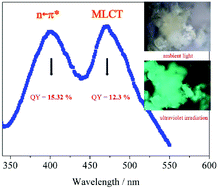
Dalton Trans., 2017,46, 16779-16782
https://doi.org/10.1039/C7DT03909C
[Cd(H2O)6]@{Cd6Cl4(nico)12[Hg(Tab)2(μ-Cl)]2}: a heterometallic host–guest icosidodecahedron cage via hierarchical assembly
A reaction of [Hg(Tab)2(nico)](PF6) (Tab = 4-(trimethylammonio)benzenethiolate, nico = nicotinate) with equimolar CdCl2·2.5H2O afforded a unique heterometallic cage complex [Cd(H2O)6]@{Cd6Cl4(nico)12[Hg(Tab)2(μ-Cl)]2}.
![Graphical abstract: [Cd(H2O)6]@{Cd6Cl4(nico)12[Hg(Tab)2(μ-Cl)]2}: a heterometallic host–guest icosidodecahedron cage via hierarchical assembly](/en/Image/Get?imageInfo.ImageType=GA&imageInfo.ImageIdentifier.ManuscriptID=C7DT02679J&imageInfo.ImageIdentifier.Year=2017)
Dalton Trans., 2017,46, 14724-14727
https://doi.org/10.1039/C7DT02679J
A cuboidal [Ni4O4] cluster as a precursor for recyclable, carbon-supported nickel nanoparticle reduction catalysts
A pyridine alkoxide ligated cuboidal [Ni4O4] cluster has been selected as the precursor to synthesize carbon-hosted Ni nanoparticles for catalytic conversion of 4-nitrophenol to 4-aminophenol.
![Graphical abstract: A cuboidal [Ni4O4] cluster as a precursor for recyclable, carbon-supported nickel nanoparticle reduction catalysts](/en/Image/Get?imageInfo.ImageType=GA&imageInfo.ImageIdentifier.ManuscriptID=C7DT01579H&imageInfo.ImageIdentifier.Year=2017)
Dalton Trans., 2017,46, 7154-7158
https://doi.org/10.1039/C7DT01579H
Evaluation of two- and three-dimensional electrode platforms for the electrochemical characterization of organometallic catalysts incorporated in non-conducting metal–organic frameworks
The development of a reliable platform to electrochemically probe a molecular diiron complex, [FeFe], grafted in a non-conductive metal–organic framework, UiO-66, is reported.
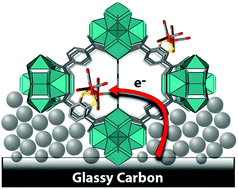
Dalton Trans., 2017,46, 4907-4911
https://doi.org/10.1039/C7DT00578D
Selective gas adsorption and fluorescence sensing response of a Zn(II) metal–organic framework constructed by a mixed-ligand strategy
By means of a mixed-ligand strategy, a novel metal–organic framework was obtained, which remarkably exhibits bi-functional properties, i.e., selective gas adsorption of CO2 over CH4 and fluorescence sensing response for nitrobenzene.
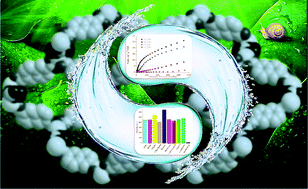
Dalton Trans., 2017,46, 4893-4897
https://doi.org/10.1039/C7DT00330G
Rational design of Co embedded N,S-codoped carbon nanoplates as anode materials for high performance lithium-ion batteries
Nanoplates with uniform Co embedded N,S-codoped carbon structures are fabricated which exhibit excellent performances as LIB anode materials.
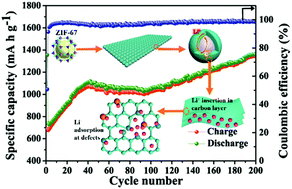
Dalton Trans., 2018,47, 12385-12392
https://doi.org/10.1039/C8DT02082E
Preparation of polynuclear NHC complexes by post-synthetic modification of half-sandwich rhodium and iridium complexes bearing C-azolato ligands
Synthesis of polymetallic structures via rational N-functionalization of half-sandwich rhodium and iridium complexes featuring C-azolato ligands.
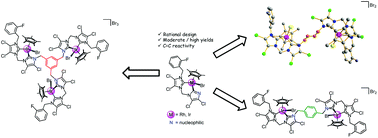
Dalton Trans., 2018,47, 9442-9452
https://doi.org/10.1039/C8DT02212G
Efficient yellow electroluminescence of four iridium(III) complexes with benzo[d]thiazole derivatives as main ligands
Four yellow iridium(III) complexes with benzo[d]thiazole derivatives as the main ligands display good device performances with a maximum current efficiency of up to 69.8 cd A−1 and a maximum external quantum efficiency of up to 24.3%.
![Graphical abstract: Efficient yellow electroluminescence of four iridium(iii) complexes with benzo[d]thiazole derivatives as main ligands](/en/Image/Get?imageInfo.ImageType=GA&imageInfo.ImageIdentifier.ManuscriptID=C8DT01479E&imageInfo.ImageIdentifier.Year=2018)
Dalton Trans., 2018,47, 8032-8040
https://doi.org/10.1039/C8DT01479E
Construction of half-sandwich multinuclear complexes including tunnel architectures via C–H-activation-directed assembly
Half-sandwich bi-, tetra-, hexa- and octanuclear complexes were prepared via C–H-activation-directed assembly based on three aromatic ligands. A series of tunnel architectures were observed in the complexes, with guest molecules in certain parts.
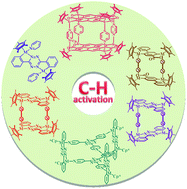
Dalton Trans., 2018,47, 7701-7708
https://doi.org/10.1039/C8DT01140K
Controllable assembly of rectangular macrocycles bearing different numbers of unsaturated sites based on half-sandwich iridium fragments
Three novel rectangular metallacycles without unsaturated metal sites and with one or two unsaturated metal sites have been constructed from pyrazine-2,3-diamine and/or 2,3-dihydroxy-quinoxaline proligands.

Dalton Trans., 2018,47, 6378-6385
https://doi.org/10.1039/C8DT00461G
Preparation of carbon-based AuAg alloy nanoparticles by using the heterometallic [Au4Ag4] cluster for efficient oxidative coupling of anilines
A unique carbon-based AuAg alloy nanocomposite catalyst was prepared from the heterometallic [Au4Ag4] cluster for efficient oxidative coupling of anilines.
![Graphical abstract: Preparation of carbon-based AuAg alloy nanoparticles by using the heterometallic [Au4Ag4] cluster for efficient oxidative coupling of anilines](/en/Image/Get?imageInfo.ImageType=GA&imageInfo.ImageIdentifier.ManuscriptID=C8DT00695D&imageInfo.ImageIdentifier.Year=2018)
Dalton Trans., 2018,47, 5780-5788
https://doi.org/10.1039/C8DT00695D
Stoichiometrically controlled chirality inversion in zinc bisporphyrinate–monoamine complexes
A novel bisporphyrin with a naphthalenecarboxamide substituent on the linker demonstrates tuning of chirality transfer from guest to host. Stoichiometrically controlled chirality inversion was observed with 1-(1-naphthyl)ethylamine as the guest.
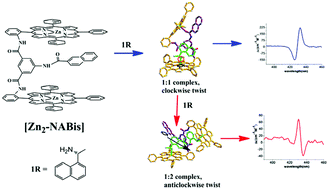
Dalton Trans., 2018,47, 5503-5512
https://doi.org/10.1039/C8DT00326B
Water molecule induced reversible single-crystal-to-single-crystal transformation between two trinuclear Fe(II) complexes with different spin crossover behaviour
Water molecule induced reversible single-crystal-to-single-crystal transformation between two trinuclear Fe(II) complexes with different spin crossover behaviour.
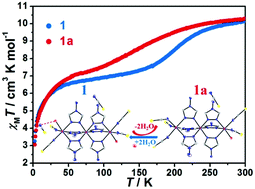
Dalton Trans., 2018,47, 4307-4314
https://doi.org/10.1039/C8DT00318A
A macrocyclic silver polycarbene complex based on 1,2,4-triazole units: synthesis and postsynthetic modification
A method for the synthesis of a new rectangular 1,2,4-triazole-containing macrocycle via photochemical [2 + 2] cycloaddition with a metal–carbene template was developed.
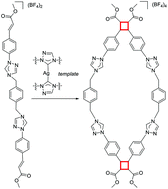
Dalton Trans., 2018,47, 4267-4272
https://doi.org/10.1039/C8DT00169C
Light-initiated reversible conversion of macrocyclic endoperoxides derived from half-sandwich rhodium-based metallarectangles
A series of metallarectangles were synthesized by an anthracene-based ligand and three different half-sandwich rhodium precursors. The photochemical reactions show that these metallarectangles can be reversibly converted to the macrocyclic endoperoxides.
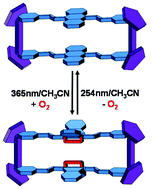
Dalton Trans., 2018,47, 2769-2777
https://doi.org/10.1039/C7DT03962J
Host–guest capability of a three-dimensional heterometallic macrocycle
Three-dimensional heterometallic macrocycles with half-sandwich Rh corners were studied for their ability to trap planar and non-planar guests. Furthermore, these heterometallic macrocycles can be destroyed in the presence of a soft base to form hexanuclear triangular prism complexes.
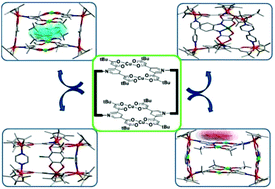
Dalton Trans., 2018,47, 2240-2246
https://doi.org/10.1039/C7DT04453D
New organometallic imines of rhenium(I) as potential ligands of GSK-3β: synthesis, characterization and biological studies
Amino-piperazines and organometallic imines were synthetized and evaluated in HT-29 and PT-45 cancer cell lines. Computational studies were also developed.
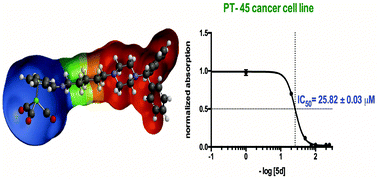
Dalton Trans., 2018,47, 1233-1242
https://doi.org/10.1039/C7DT04344A
Luminescent cadmium(II) coordination polymers of 1,2,4,5-tetrakis(4-pyridylvinyl)benzene used as efficient multi-responsive sensors for toxic metal ions in water
One luminescent cadmium(II) coordination polymer of 1,2,4,5-tetrakis(4-pyridylvinyl)benzene works as an efficient multi-responsive sensor for Hg2+, CrO42− and Cr2O72− in water.
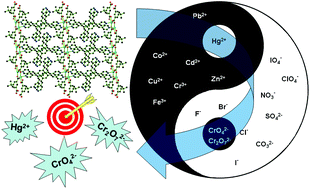
Dalton Trans., 2017,46, 16861-16871
https://doi.org/10.1039/C7DT03876C
A wheel-shaped Dy(III) single-molecule magnet supported by polyoxotungstates
A wheel-shaped Dy(III) single-molecule magnet with an idealized S6 symmetry is supported by polyoxotungstates. The anisotropic barrier is extracted from AC susceptibilities and the emission spectrum offers insight into the magneto-optical correlation.
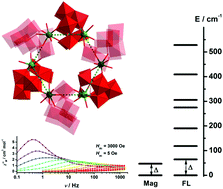
Dalton Trans., 2017,46, 16796-16801
https://doi.org/10.1039/C7DT03721J
Bimetallic metal–organic framework derived Co3O4–CoFe2O4 composites with different Fe/Co molar ratios as anode materials for lithium ion batteries
The morphology and electrochemical performance of the as-prepared Co3O4–CoFe2O4 composites from bimetallic metal–organic framework precursors depend greatly on the initial Fe3+/Co2+ molar ratio.
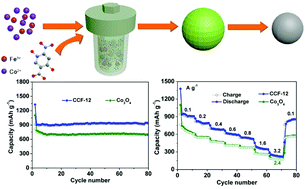
Dalton Trans., 2017,46, 15947-15953
https://doi.org/10.1039/C7DT03047A
Benzannulated Re(I)–NHC complexes: synthesis, photophysical properties and antimicrobial activity
A series of novel Re(I)(CO)3–NHC complexes bearing unsubstituted benzimidazol-2-ylidene ligands is presented which provide strong luminescence as well as high antibacterial activity.

Dalton Trans., 2017,46, 15269-15279
https://doi.org/10.1039/C7DT02874A
The synthesis and reactivity of 16-electron half-sandwich iridium complexes bearing a carboranylthioamide ligand
The 16-electron complex 2 has been synthesized. It can react with different donor ligands and undergoes M–S bond insertion reactions with DMAD. Complex 2 is shown to react with [Cp*Ir] unit to form a M–M-bound binuclear complex. Interestingly, the metal–metal bond could be broken by HCl to produce the selective B(6)–H activation species.

Dalton Trans., 2017,46, 15535-15540
https://doi.org/10.1039/C7DT03529B
Design and validation of a new ratiometric intracellular pH imaging probe using lanthanide-doped upconverting nanoparticles
A ratiometric probe based on upconversion nanoparticles modified with a pH sensitive moiety for the quantitative imaging of pH at the subcellular level in living cells.
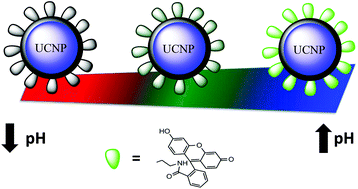
Dalton Trans., 2017,46, 13957-13965
https://doi.org/10.1039/C7DT02418E
Thermal expansion and magnetic properties of benzoquinone-bridged dinuclear rare-earth complexes
The complexes [BQ(MCl2·THF3)2] (M = Y or Dy) possessing pentagonal bipyramidal environment around metal centers undergo significant thermal expansion as revealed by single-crystal X-ray and powder diffraction experiments.
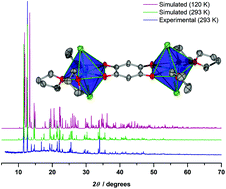
Dalton Trans., 2017,46, 13582-13589
https://doi.org/10.1039/C7DT02565C
Electronic and molecular structure relations in diiron compounds mimicking the [FeFe]-hydrogenase active site studied by X-ray spectroscopy and quantum chemistry
X-ray spectroscopy and DFT on diiron complexes revealed correlations of spectroscopic, electronic, and structural features.
![Graphical abstract: Electronic and molecular structure relations in diiron compounds mimicking the [FeFe]-hydrogenase active site studied by X-ray spectroscopy and quantum chemistry](/en/Image/Get?imageInfo.ImageType=GA&imageInfo.ImageIdentifier.ManuscriptID=C7DT02720F&imageInfo.ImageIdentifier.Year=2017)
Dalton Trans., 2017,46, 12544-12557
https://doi.org/10.1039/C7DT02720F
Low-temperature-flux syntheses of ultraviolet-transparent borophosphates Na4MB2P3O13 (M = Rb, Cs) exhibiting a second-harmonic generation response
The first SHG-active mixed-alkali-metal borophosphates, Na4MB2P3O13 (M = Rb 1, Cs 2), have been obtained via a low-temperature flux method.
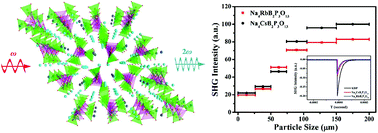
Dalton Trans., 2017,46, 12605-12611
https://doi.org/10.1039/C7DT02649H
Synthesis of divalent ytterbium terphenylamide and catalytic application for regioselective hydrosilylation of alkenes
Divalent ytterbium terphenylamide exhibited high regioselectivity and activity in the hydrosilylation of alkenes with low catalyst loadings.

Dalton Trans., 2017,46, 10957-10962
https://doi.org/10.1039/C7DT01837A
Stepwise construction of discrete parallelogram- and prism-shaped organometallic architectures based on half-sandwich rhodium fragments
Using a versatile pyridyl-substituted imidazole-4,5-dicarboxylate proligand, together with half-sandwich rhodium fragments, a series of discrete organometallic complexes with parallelogram and trigonal prism shapes were constructed stepwise.

Dalton Trans., 2017,46, 10498-10503
https://doi.org/10.1039/C7DT02186K
Aminoalcohols and benzoates-friends or foes? Tuning nuclearity of Cu(II) complexes, studies of their structures, magnetism, and catecholase-like activities as well as performing DFT and TDDFT studies
The Cu(II) complexes of varying nuclearity are synthesized, characterized and assessed for catecholase activities.
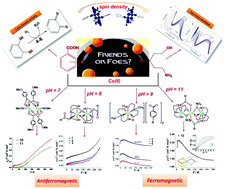
Dalton Trans., 2017,46, 9801-9823
https://doi.org/10.1039/C7DT01571B
Controlled synthesis of cyclosiloxanes by NHC-catalyzed hydrolytic oxidation of dihydrosilanes
Hydrolytic oxidation of dihydrosilanes with water in acetonitrile with 0.1 mol% of NHC produced hydrogen gas and cyclosiloxanes in excellent yields.

Dalton Trans., 2017,46, 8746-8750
https://doi.org/10.1039/C6DT04882J
Controllable construction of half-sandwich octanuclear complexes based on pyridyl-substituted ligands with conjugated centers
Based on three tetradentate ligands with conjugated centers, seven half-sandwich octanuclear complexes were selectively obtained. Several subsequent structural conversions were also successfully conducted.
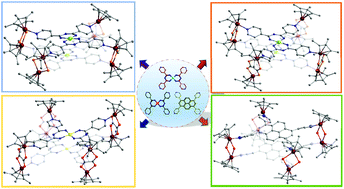
Dalton Trans., 2017,46, 8190-8197
https://doi.org/10.1039/C7DT00836H
Magnetostructural relationship for μ2-phenoxido bridged ferric dimers
The magneto-structural correlation between μ2-phenoxido bridged iron(III) complexes are studied by structural analyses, magnetic, HF-EPR measurements, and DFT calculations. The magnetic exchange coupling is governed by the Fe–O–Fe angle and the crossover point from AF to F interactions is θ at 97.83°.
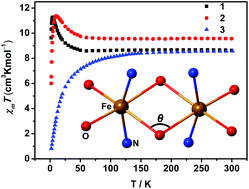
Dalton Trans., 2017,46, 4317-4324
https://doi.org/10.1039/C7DT00110J
A heterometallic ferrimagnet based on a new TTF-bis(oxamato) ligand
An interesting heterometallic one-dimensional complex {[Cu(TTF-opba)][Mn(CH3OH)2]}n based on a π-extended TTF ligand was prepared through the method of “metalloligand”. It retains the redox activity and shows ferrimagnetic behavior.
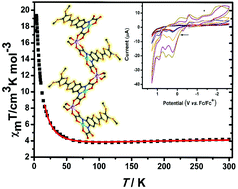
Dalton Trans., 2017,46, 3980-3988
https://doi.org/10.1039/C6DT04903F
Phthalocyanine supported dinuclear LnIII complexes: the solvent-induced change of magnetic properties in dysprosium(III) analogues
Three phthalocyanine-supported dinuclear LnIII complexes were obtained and characterized. The DyIII analogue exhibits reversible solvent dependent single-molecule magnetic properties between a single relaxation and a dual relaxation process.
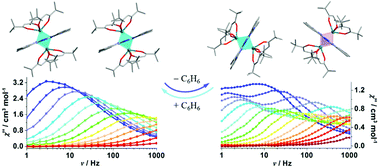
Dalton Trans., 2017,46, 3353-3362
https://doi.org/10.1039/C7DT00298J
Two new metal–organic frameworks based on tetrazole–heterocyclic ligands accompanied by in situ ligand formation
Two new MOFs have been constructed by the Dimroth rearrangement of the in situ generated organic ligand 5-((2H-tetrazol-5-yl)amino)isophthalic acid (H3L).
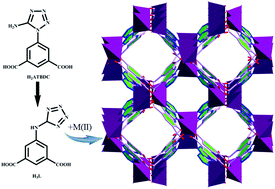
Dalton Trans., 2017,46, 3223-3228
https://doi.org/10.1039/C7DT00005G
Redox state manipulation of a tris(p-tetrazolylphenyl)amine ligand and its Mn2+ coordination frameworks
Two new Mn2+-based metal–organic frameworks containing the tris(p-tetrazolylphenyl)amine (H3TTPA) ligand exhibit multiple redox-accessible states which have been interrogated using in situ solid state spectroelectrochemical methods.
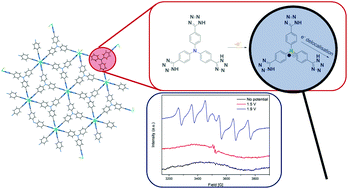
Dalton Trans., 2017,46, 2998-3007
https://doi.org/10.1039/C6DT04719J
Di- and octa-nuclear dysprosium clusters derived from pyridyl-triazole based ligand: {Dy2} showing single molecule magnetic behaviour
DyIII-based two complexes, {Dy2} (1) and {Dy8} (2), were successfully isolated with H2bpte ligand. In 1, H2bpte bears trans,trans- while in 2 has cis,cis- coordination modes. {Dy2} displays the single-molecule magnet behaviour with an energy barrier Ueff = 59(4) K.

Dalton Trans., 2017,46, 2981-2987
https://doi.org/10.1039/C7DT00047B
Palladium(II) and palladium(II)–silver(I) complexes with N-heterocyclic carbene and zwitterionic thiolate mixed ligands: synthesis, structural characterization and catalytic properties
A combination of Pd(II), an N-heterocyclic carbene (NHC), and a thiolate (Tab) yields several Pd–NHC–Tab complexes and an octanuclear Pd4Ag4–NHC–Tab cluster.
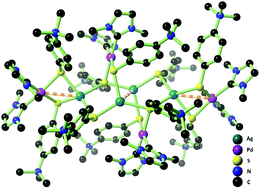
Dalton Trans., 2017,46, 1832-1839
https://doi.org/10.1039/C6DT04599E
Efficient synthesis of carborane azo derivatives and their reactivity
An iridium(III)-catalyzed C–N-bond-forming direct synthesis of carborane azo derivatives was developed.

Dalton Trans., 2017,46, 1585-1592
https://doi.org/10.1039/C6DT04550B
Electrocatalytic water oxidation by a molecular catalyst incorporated into a metal–organic framework thin film
A molecular ruthenium complex incorporated into FTO-grown thin films of UiO-67 catalyzes electrochemical water oxidation.
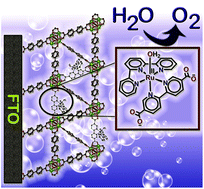
Dalton Trans., 2017,46, 1382-1388
https://doi.org/10.1039/C6DT03718F
3D oxalato-bridged lanthanide(III) MOFs with magnetocaloric, magnetic and photoluminescence properties
Four isostructural 3D lanthanide(III) metal–organic frameworks with the general formula (H6edte)0.5[LnIII(ox)2(H2O)] (Ln = Gd (1), Tb (2), Dy (3) and Ho (4); H4edte = N,N,N′,N′-tetrakis(2-hydroxyethyl)ethylenediamine) and ox = oxalate have been synthesized from oxalate.
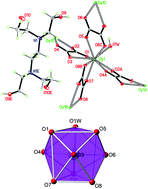
Dalton Trans., 2017,46, 116-124
https://doi.org/10.1039/C6DT03843C
About this collection
In November Dalton Transactions is holding a series of symposia on the theme of Advancing Inorganic Chemistry. These one-day meetings will be held in three different cities – Tianjin, Nanjing, and Shanghai – and feature presentations on the cutting edge of inorganic chemistry by leading researchers from around the world. This is a collection of recent papers in Dalton Transactions by the hosts and speakers of the symposia.
Check out our blog for more details of these events and links to the registration pages.